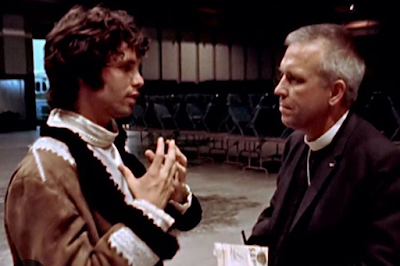"EASY RIDE" BY THE DOORS: CABARET IN 1968
The Doors' song "Easy Ride" closes the A-side of the group's fourth album, “The Soft Parade” (released in July 1969, it peaked at number 6 in the United States but did not enter the UK charts).
Considered by many to be their worst work, this LP suffers from a
decline in cohesion among the musicians, a cohesion that had previously been
one of the group's major strengths.
“Easy Ride” would later be used as the B-side of the single “Tell All
the People”, which only reached number 57 in the US a month before the release
of the album “The Soft Parade”, which contained both songs.
Despite this, “Easy Ride” was recorded a year and four months earlier,
in early March 1968.
In fact, during the studio sessions that resulted in the previous album,
“Waiting For The Sun”, this composition, attributed to Morrison, had already
been completed in its final form, exactly as can be heard on “The Soft Parade”.
Its exclusion from “Waiting for the Sun” is mainly due to two factors.
Firstly, the song itself is objectively weak, not reaching the standard
of the great songs The Doors had produced up to that point.
Secondly, it is similar to "We Could Be So Good Together", the
ninth track on "Waiting for the Sun", in terms of inspiration and
overall musicality.
Like "We Could Be So Good Together", "Easy Ride"
draws its sounds from early 20th-century "music hall".
This genre, also known as vaudeville or cabaret, represented popular
entertainment music at the beginning of the last century.
It was closely associated with live shows combining theatre, dance,
comedy and music, performed in public venues in the evening and at night in the
United States and England.
The Doors had already drawn inspiration from cabaret for several earlier
songs: "Alabama Song", "People Are Strange" and, as noted
above, "We Could Be So Good Together".
So, 'Easy Ride' marks the fourth time that the band has recorded a
cabaret-inspired song.
This composition has a relaxed atmosphere defined by a light-hearted
spirit and unpretentious execution.
The arrangement is the result of an ongoing exchange of tasty cabaret
clichés between the electric organ (played by Ray Manzarek) and the electric
guitar (played by Robby Krieger).
The drums and electric bass (the latter played by the great session
musician Doug Lubahn) maintain a fast and urgent pace, in line with the musical
context.
Morrison's vocal performance is undoubtedly the highlight of "Easy
Ride". His voice is particularly allusive and expressive, breaking away
from the rock paradigm he is more familiar with.
It should be noted that without Morrison's vocals, the song would
struggle to remain interesting.
Furthermore, Morrison shows that he can master casual and relaxed vocal
nuances, which are quite different from the dark, intense style for which he is
famous.
The singer is also the author of the lyrics. Although intentionally
cryptic at times, the words outline a tension towards loving desire, expressed
through Jim Morrison's signature poetic language.
The two metaphors that juxtapose the woman's eyes with black, polished
stones and her smile with burning glass are particularly inspired, original and
incisive.
“Easy Ride” can be considered a filler track, retrieved from the previous
year and included on the A-side of the “Soft parade” album.
Despite its somewhat unconvincing connotations, the song retains some
charm, largely thanks to its vaudeville musical foundation.
This is faithfully recreated through the evocative use of electric
instruments, which, of course, are outside the tradition of the "music
hall". In this way, the tune takes the listener on an entertaining,
dreamlike journey through a vintage, sparkling sonic environment.
P.S.: My book "The Doors Through Strange Days"- The most comprehensive journey ever made through The Doors' second LP, is available on Amazon.com, .uk, .mx, .it, etc.
Here’s a link:




Comments
Post a Comment